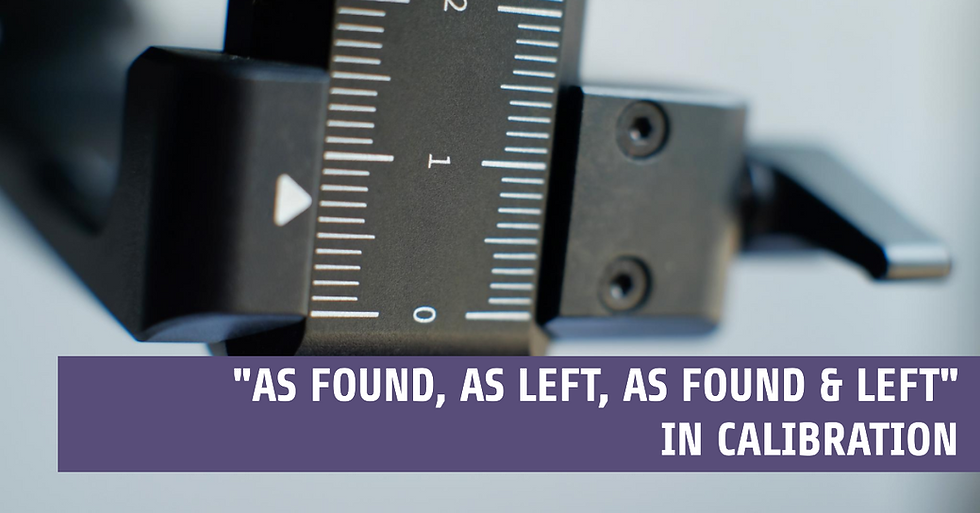The Elusive Equipment: Why Tracking Your Calibration Assets is a Silent Struggle
- Ajayvignesh MV
- Jun 5
- 4 min read
Have you ever wasted precious time searching for a critical piece of calibration equipment, only to find it in an unexpected corner or even worse, realize it's overdue for calibration because it got lost in the shuffle? If so, you're not alone. The struggle to effectively track calibration equipment is a common pain point for businesses of all sizes, leading to costly delays, compliance risks, and inaccurate measurements. But what if there was a way to make this process seamless and stress-free? Let's dive into the fundamental approaches to equipment tracking.

Beyond the Clipboard: Unpacking Traditional and Modern Tracking Methods
Before we unveil advanced solutions, it's essential to understand the spectrum of equipment tracking methods available. From the tried-and-true manual approaches to the latest in automated technology, each method offers distinct advantages and disadvantages. Curious to see which one aligns with your current operations or future aspirations? Let's explore.
1. The Manual Logbook: Simplicity with a Catch
The most basic method involves a physical logbook or a simple spreadsheet where technicians manually record the movement and status of equipment. While incredibly straightforward and low-cost to implement, this method is highly prone to human error, can be incredibly time-consuming to update, and offers no real-time visibility. Imagine trying to locate a specific gauge across multiple departments using just a paper trail – it's a nightmare waiting to happen! So, how can we improve on this foundational approach?
2. Barcode Scanning: A Step Up in Efficiency
Implementing barcode labels on each piece of equipment and using barcode scanners to log check-ins and check-outs offers a significant improvement over purely manual methods. This reduces transcription errors and speeds up the logging process. However, it still requires manual scanning, and real-time location tracking isn't possible – you only know where it was last scanned. Is there a way to get more real-time insights without constant manual intervention?
3. QR Code Tracking: The Smartphone Advantage
Similar to barcodes, QR codes can be used for tracking, with the added benefit that they can often be scanned using a standard smartphone camera. This can lower the barrier to entry for some organizations. Like barcode scanning, it improves data accuracy and speed compared to purely manual methods, but still relies on active scanning and doesn't provide continuous location updates. If you're looking for something that automatically knows where your equipment is, what's next?
4. RFID Tracking: The Future is Here (and Hands-Off!)
Radio-Frequency Identification (RFID) technology offers a far more automated and hands-off approach. Small RFID tags are attached to each piece of equipment, and RFID readers are strategically placed in key locations (e.g., doorways, workbenches). When an RFID-tagged item passes by a reader, its presence is automatically logged. This provides real-time location data and significantly reduces the need for manual intervention. But what if you want to integrate this advanced tracking with comprehensive equipment management?
5. GPS Tracking (for larger, mobile assets): Beyond the Walls
For very large, expensive, or mobile calibration equipment that frequently leaves the premises (e.g., portable calibration carts used for field service), GPS trackers can be installed. This provides continuous, real-time location data, invaluable for logistics and security. While not typically used for smaller gauges, it's a powerful tool for specific high-value assets. Now that we've covered the diverse landscape of tracking methods, how can a dedicated system tie all of this together and offer even more?
GageMakkal: Your Intelligent Partner in Calibration Equipment Management
You've seen the challenges and the spectrum of solutions. Now, imagine a system that not only integrates these tracking methods but also empowers you with unparalleled visibility and control over your entire calibration equipment ecosystem. Welcome to GageMakkal – designed to transform your equipment tracking from a burden into a strategic advantage.
1. Manual Tracking with Unprecedented Detail: Beyond the Basics
GageMakkal elevates manual tracking by allowing you to organize your calibration equipment based on "cluster groupings" and specific physical locations. What does this mean for you? You can assign a virtual map or a floor plan to each cluster, allowing you to visually pinpoint the exact location of every piece of equipment within that group. When a technician or operator moves an equipment, they can simply update its location manually within the system, ensuring that your virtual map always reflects the real-world position. This level of detail, even with manual updates, drastically reduces search times and improves accountability. But what if you want to eliminate manual updates altogether?
2. Active Tracking with RFID: Real-Time Precision at Your Fingertips
For organizations seeking maximum automation and real-time accuracy, GageMakkal seamlessly integrates with RFID technology. By affixing RFID tags to each equipment and strategically placing RFID readers throughout your facility, GageMakkal can actively track the movement of your assets. Whenever an equipment is scanned by a reader, its location is automatically updated in the system. Our sophisticated integration even allows for advanced scenarios where a reader scanning a whole doorway can log equipment movement without needing the tag to be precisely near the reader. This provides an unparalleled level of hands-off tracking, ensuring you always know where your critical equipment is, when it was last moved, and who moved it. Imagine the peace of mind knowing your calibration assets are always accounted for, freeing up your team to focus on what truly matters.
The Bottom Line: Why Smart Tracking is Non-Negotiable
Effective calibration equipment tracking isn't just about avoiding lost items; it's about optimizing workflows, ensuring compliance with industry standards, minimizing downtime, and ultimately, safeguarding the accuracy of your measurements. Whether you opt for a highly detailed manual approach or embrace the automation of RFID, a robust tracking system like GageMakkal empowers you to make informed decisions and maintain complete control over your valuable assets. Isn't it time you stopped searching and started knowing?




Comments